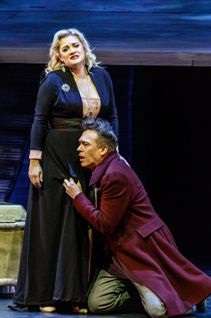|
Back
A Fatal Potion Melbourne
Palais Theatre
02/05/2018 - & February 7, 10, 2018
Richard Wagner: Tristan und Isolde
Neal Cooper (Tristan), Lee Abrahmsen (Isolde), Sarah Sweeting (Brangäne), Michael Lampard (Kurwenal), Steven Gallop (Marke), Jason Wasley (Melot), Michel Dimovski (Shepherd), Stephen Marsh (Steersman), Henry Choo (Sailor)
Melbourne Opera Chorus, Raymond Lawrence (Chorus Master), Melbourne Opera Orchestra, Anthony Negus (Conductor)
Suzanne Chaundy (Director), Greg Hocking (Producer), Greg Carroll (Set Designer), Lucy Birkinshaw (Lighting, Costumes), Yandell Walton, Keith Deverell (Video Designers)

L. Abrahmsen, N. Cooper (© Robin Halls)
The immensity of Wagner’s Tristan and Isolde cannot be underestimated. Its expansive emotional palette, the sweeping journey across sea and land, the astonishingly huge singing role of Isolde in particular and not least, the sheer length of the score all make for a heavy-duty opera which tests the inventiveness of the cast and creative team as well as the stamina of the audience. Melbourne Opera’s delayed first night – the indisposition of the soprano forcing a re-schedule – was well up to task and was enthusiastically received by a large audience.
The monumental Art Deco splendour of Melbourne’s Palais Theatre – Australia’s largest seated venue performance space – was home to this production, its air of grandeur contrasting with the sparse, focussed production directed by Suzanne Chaundy. Late on a blazing summer afternoon, we began our journey into the darkness of the Irish Sea, finishing well after dark on a balmy evening when the world had been consumed in flames and waves brought love and life to a closure.
The creative team tamed the enormous Palais Theatre stage using video projections: the swelling sea, crashing waves, the interior of an opalescent cave, the distant foggy shore and finally flames which bring about the atonement devotedly sought by the protagonists. This is a master stroke of theatrical design which not only contains each act but reflects the often mesmeric swelling of the orchestra in the many instrumental interludes.
For this grand undertaking, Melbourne Opera have been fortunate to engage the services of acclaimed British conductor Anthony Negus. Bringing extensive experience in Wagner’s operas, he offers authoritative leadership to the greatly expanded Melbourne Opera Orchestra. Incorporating more than ninety players, many of them noticeably younger than the regular band, they produced an often gorgeous, always sumptuous sound. No doubt, this will be a great learning experience for all players as well as the vocal cast, able to draw upon his wealth of knowledge and international experience. It is this kind of ambitious and inventive venture which makes this financially independent company a beacon for the music performance scene not only in Melbourne but throughout this country and beyond.
The many instrumental intermezzi were deftly handled. The throbbing intensity of the sea; the enigmatic Tristan Chord expanding into the motifs for love, death, night and day; and the driving force of the inevitability of fate were all depicted with great sensitivity and detail. In the wider score, the strings were especially luscious. They floated under the singers, gently bolstering their vocal lines while simultaneously evoking their own highly complex combinations of motifs and melody. This element of making the complex serene and soothing must be the most important of the many skills Maestro Negus brings to this production.
The designers have kept the whole stage concept simple and thought provoking. A huge double stair leads to an upper deck which variously becomes the stern of the ship, the roof of a cave and Tristan’s castle at Kareol. Beneath this deck and only partially visible, a colonnaded space is the below-deck of the ship, the depths of the lovers’ darkened meeting place and a shelter near the sea awaiting Isolde’s arrival. It is a clever design which serves the performers well, never intruding upon the intensity of the text or music. The video projections are atmospheric and suggestive again, supporting the action and dialogue.
For this series of performances, Melbourne Opera have engaged British tenor Neal Cooper as their Tristan. He is very experienced in this role including his recent cover for the MET in New York. Mr. Cooper’s Tristan is developed methodically throughout the performance. However, there are unswerving elements of chivalry, dedication and romanticism which steer the character throughout. He captures power, sensuality and honour unerringly but we sense a fragility of personality especially as he and Isolde commit themselves to the tragic course of love. Mr. Cooper’s beautiful diction and his clarion upper register ensure riveted attention to his presence on-stage.
Melbourne soprano Lee Abrahmsen’s Isolde is her second venture into the female characters of Wagner, having performed Elizabeth for MO’s production of Tannhäuser in 2016. In her very capable hands, this is a real person who loves, hates, demands and provokes and doubts herself in a complex portrait. She has a searing upper register which commands attention and is a beautiful match for the voice of her fellow protagonist. She is equally as capable of transfixing with quietude and mellow contemplation which makes for a varied and widely drawn reading of this character.
As Brangäne, Sarah Sweeting’s rich mezzo voice urges caution and concern which are never to be heeded. Hers becomes a desperate, driven picture of a devoted companion pushed to the limits of her love and initiative. Michael Lampard’s Kurwenal and Steven Gallop’s King Marke are both strongly delivered and well-rounded portrayals. Both men have strong voices and both have commanding stage presences. Mr. Gallop in particular was galvanising as the bereft king. Many of the performers in this production are supported by the Richard Dival Emerging Artists Program, another superb achievement by the company.
Gregory Pritchard
|